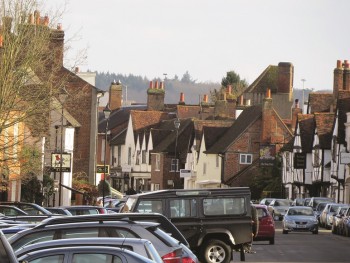Blog
Out with the old? In with the new?
Friday, February 4, 2022

Most towns grow and evolve over the years, embracing old and new build, learning from the past but incorporating new design and planning for future needs. This is particularly true within The Frost Partnership’s network area spanning Buckinghamshire, Berkshire, and Middlesex. Some towns, such as Chesham, have simply embraced the old heart of the town within designated conservation areas as organic growth expands outwards, stretching its geographic boundaries. Others, such as the new and old towns of Beaconsfield, sit more like distant relatives, barely touching and almost a mile apart.
But, apart from housing needs, what prompted the growth of distinct, geographically separate new towns in the past? In Amersham, the growth of the “new” town reflected the coming of the railway and the increasing focus on commuting to London. Following the arrival of the Metropolitan Railway, Amersham-on-the-Hill grew rapidly around the station. Ironically, the railway was not very popular at the time. Objections from local landowners delayed its construction until 1892, yet the railway station, a mile north of the old market town, provided the basis for Amersham’s prosperity.
Replicating this scenario, Beaconsfield station, one mile from the old town, became the focus for the new town when the railway arrived in 1906. Like Amersham, Beaconsfield built on its commuter links with the creation of upmarket family housing and superb schooling, allowing the town to prosper further throughout the 20th century.
New towns tend to offer a different range of property types with larger, upscale units (both residential and commercial), contemporary design and less dependence on local materials as transport methods have improved. While old towns in the Southeast tend to feature a mix of local stone, brick, flint and timber, new towns are less governed by this, using more glass and concrete, although increasingly architecture has come full circle, once again incorporating traditional materials.
There has been a river crossing at Staines-upon-Thames since Roman times and Staines became a regular staging post en route to the capital with coaching inns and elaborate Georgian shophouses which still line Clarence Street. Church Street and Lammas Lane house the oldest properties, clustered around the parish church of St Mary. The old town has however been engulfed by the massive facelift and infrastructural developments that Staines has received in recent years. The postal town of Staines-upon-Thames encompasses entire villages such as Laleham and includes Egham Hythe on the opposite bank of the river, which contains a significant business area and some of the town's oldest listed buildings.
Although it’s hard to see where old and new town begin and end in Chesham, they are entirely separate council wards. Newtown was a late Victorian housing development to the north of Chesham which has been incorporated into the town; Old Town, until the railway’s arrival in 1889, was the town's centre. Nowadays, St Mary's Church and historic buildings on Church and Germain Street, are part of a designated Conservation Area just south of the present town centre. The pedestrianised High Street retains the character of the old market town with traditional retailers and a street market. This character was highlighted in a survey of town 'high streets' which rated Chesham highly for its distinctiveness. Considerable expansion of the town has created new housing developments shaped by the steep valley sides. Increasingly Chesham has become a commuter town with faster connection to London. The town centre was redeveloped and pedestrianised in the 1990s, but further growth has been restricted by Green Belt legislation.
Slough does not automatically spring to mind as having an old town but, from the mid-17th century onwards, it was a popular stop for stagecoaches on the journey west from London. It still has 96 listed buildings including St Mary the Virgin Church (Langley), Baylis House, Godolphin Court, Upton Court, Ostrich Inn, and King John's Palace (Colnbrook). The best conserved area of old Slough is Herschel Park (known as Upton Park until 1949), currently being re-landscaped to restore it to its former Victorian glory.
It is now very much a case of “in with the new” as Slough has undergone massive redevelopment of the town centre as a focus for the creative media, information, and communications industries. Alongside this, SEGRO (owner of the Slough Trading Estate) is actioning plans to spend £600m creating environmentally sustainable buildings, open green spaces, hotels, conference centre and better transport facilities. It aims to create over 4,000 jobs and contribute £100m a year to Slough's economy. If these plans progress fully, almost £1bn will be spent on the redevelopment of Slough over the next 20 years.
From aesthetics to amenities, both old and new towns have a welcome place in the 21st century, often fostering one another’s growth and development. With careful planning, they comfortably co-exist and are important elements of a town’s story. To find out more about these and other towns and villages in The Frost Partnership network area see our area guides or contact your local Frost office.















